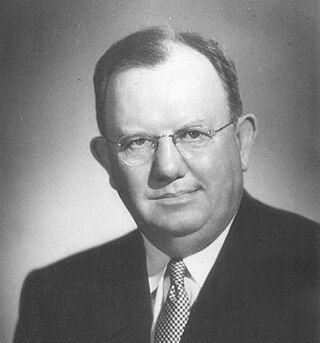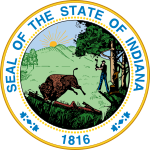
The 1982 United States Senate elections were held on November 2, 1982. They were elections for the United States Senate following Republican gains in 1980. The 33 Senate seats of Class 1 were up for election in 1982. A total of four seats changed hands between parties, with Democrats winning seats in New Jersey and New Mexico, and Republicans taking seats in Nevada and the seat of the lone independent, Senator Harry Byrd Jr., in Virginia. Democrats made a net gain of one seat bringing them to 46 seats, while Republicans stayed at 54 seats for a majority. However, the Democratic gain in New Jersey replaced a Republican that had been appointed earlier in the year.

The 1978 United States Senate elections were held on November 7, in the middle of Democratic President Jimmy Carter's term. The 33 seats of Class 2 were contested in regular elections. Special elections were also held to fill vacancies.

The 1970 United States Senate elections was an election for the United States Senate. It took place on November 3, with the 33 seats of Class 1 contested in regular elections. Special elections were also held to fill vacancies. These races occurred in the middle of Richard Nixon's first term as president. The Democrats lost a net of three seats, while the Republicans and the Conservative Party of New York picked up one net seat each, and former Democrat Harry F. Byrd Jr. was re-elected as an independent.

The 1960 United States Senate elections coincided with the election of John F. Kennedy as president on November 8, 1960. The 33 seats of Class 2 were contested in regular elections. A special election was also held on June 28, 1960, for a mid-term vacancy in North Dakota where Democrats flipped a seat to expand their majority to 66–34. As Majority Leader Lyndon Johnson was elected Vice President, Mike Mansfield became the new majority leader.

The 1958 United States Senate elections were elections for the United States Senate which occurred in the middle of President Dwight D. Eisenhower's second term. Thirty-two seats of Class 1 were contested in regular elections, the new state of Alaska held its first Senate elections for its Class 2 and 3 seats, and two special elections were held to fill vacancies.

The 1948 United States Senate elections were elections which coincided with the election of Democratic President Harry S. Truman for a full term. The 32 seats of Class 2 were contested in regular elections, and one special election was held to fill a vacancy. Truman had campaigned against an "obstructionist" Congress that had blocked many of his initiatives, and in addition the U.S. economy recovered from the postwar recession of 1946–1947 by election day. Thus Truman was rewarded with a Democratic gain of nine seats in the Senate, enough to give them control of the chamber. This was the last time until 2020 that Democrats flipped a chamber of Congress in a presidential election cycle.

Maurice Clifford Townsend was an American politician and the 35th governor of the U.S. state of Indiana from 1937 to 1941. During his term, he led relief efforts during and after the Great Flood of 1937.

Frederick Van Nuys was a United States senator from Indiana. Born in Falmouth, he attended the public schools and graduated from Earlham College in 1898 and from Indiana Law School in 1900. He was admitted to the bar in 1900 and commenced practice in Shelbyville moving shortly afterward to Anderson. From 1906 to 1910 he was prosecuting attorney of Madison County and was a member of the Indiana Senate from 1913 to 1916, serving as president pro tempore in 1915. He moved to Indianapolis in 1916 and continued the practice of law; he was United States Attorney for the U.S. District of Indiana from 1920 to 1922.

The 1932 United States Senate election in Indiana took place on November 8, 1932. Incumbent Republican Senator and Senate Majority Leader James E. Watson ran for a third term in office, but was defeated by Frederick Van Nuys in a landslide.

The 1946 United States Senate elections in Ohio was held on November 5, 1946, alongside a concurrent special election to the same seat.

The 1928 United States Senate special election in Ohio was held on November 6, 1928 to elect a successor to Frank B. Willis, who died in office in March 1928. Republican U.S. Representative Theodore E. Burton, who previously held this seat from 1909 to 1915, won the open race to succeed him.

The United States Senate special election of 1938 in New Jersey was held on November 8, 1938.

The 1938 United States Senate election in Indiana took place on November 8, 1938. Incumbent Democratic Senator Frederick Van Nuys was narrowly re-elected to a second term in office over Raymond E. Willis by a margin of 5,197 votes out of over 1.5 million cast.

The 1946 United States Senate special election in Kentucky was held on November 5, 1946, to complete the unexpired term of Senator Happy Chandler, who resigned to become Commissioner of Baseball. Interim Senator William A. Stanfill did not run for the full term. Republican John Sherman Cooper defeated Democratic former U.S. Representative John Y. Brown to complete the term.

The 1952 United States Senate election in Indiana took place on November 4, 1952. Incumbent Republican U.S. Senator William E. Jenner was for re-elected to a second term in office over Governor of Indiana Henry F. Schricker.

The 1944 United States Senate special election in New Jersey was held on November 7, 1944.

The 1944 United States Senate elections in Indiana took place on November 7, 1944.

The 1926 United States Senate special election in Indiana was held on November 2, 1926, to complete the unexpired term of Senator Samuel M. Ralston, who died on October 14, 1925. Interim Republican Senator Arthur Raymond Robinson, who had been appointed to fill the seat, was re-elected to finish the term over Democrat Evans Woollen.

The 1940 United States Senate election in Indiana took place on November 5, 1940. Incumbent Democratic U.S. Senator Sherman Minton ran for re-election to a second term, but lost narrowly to Republican Raymond E. Willis.

The 1954 United States Senate election in North Carolina was held on November 2, 1954. Interim Democratic Senator Alton A. Lennon, who had been appointed to fill the vacant seat left by the death of Willis Smith, ran for re-election. Lennon lost the Democratic primary to former Governor W. Kerr Scott, who easily won the general election over Republican Paul C. West.




















